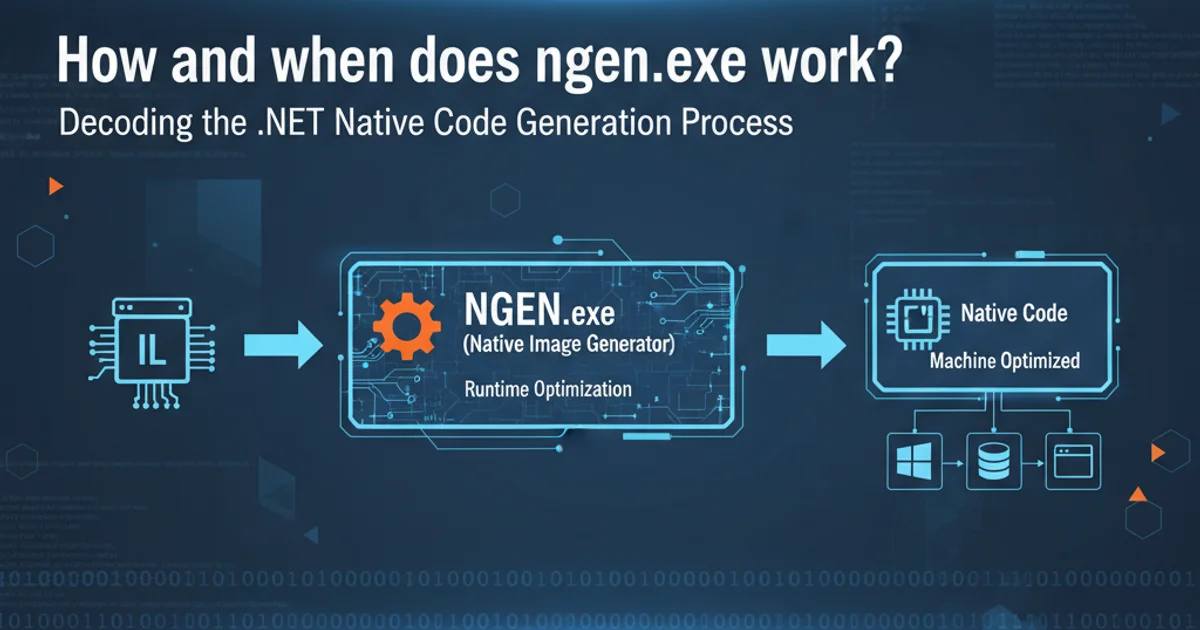How and when does ngen.exe work?
Categories:
Understanding NGEN.exe: How and When It Optimizes .NET Applications

Explore the purpose, functionality, and practical implications of NGEN.exe, the Native Image Generator, for optimizing .NET application startup performance and memory usage.
When you compile a .NET application, the source code is translated into an intermediate language (IL), not directly into machine code. This IL is then Just-In-Time (JIT) compiled into native machine code at runtime by the Common Language Runtime (CLR). While JIT compilation offers flexibility and cross-platform compatibility, it introduces a performance overhead during application startup. This is where NGEN.exe, the Native Image Generator, comes into play. NGEN.exe pre-compiles IL assemblies into native images, storing them in the Native Image Cache (NIC), to improve startup time and potentially reduce memory footprint for subsequent runs.
What is NGEN.exe and How Does It Work?
NGEN.exe is a command-line tool provided with the .NET Framework and .NET Core/5+ SDKs. Its primary function is to create native images of managed assemblies. These native images are processor-specific machine code files that can be loaded directly by the CLR, bypassing the JIT compilation step for those assemblies. This pre-compilation process occurs during installation or explicitly by an administrator, rather than at application runtime.
flowchart TD
A[Source Code] --> B[C# Compiler]
B --> C[Intermediate Language (IL) Assembly]
C -- JIT Compilation (Runtime) --> D[Native Machine Code (RAM)]
C -- NGEN.exe (Install/Admin) --> E[Native Image (Disk)]
E --> DComparison of JIT compilation vs. NGEN pre-compilation
The native images generated by NGEN.exe are stored in the Native Image Cache (NIC). When an application starts, the CLR first checks the NIC for a suitable native image. If found, it loads the native image directly, significantly reducing startup time. If a native image is not found or is invalid (e.g., due to an assembly update), the CLR falls back to JIT compilation.
When to Use NGEN.exe
NGEN.exe is most beneficial in specific scenarios where startup performance is critical and applications are frequently run. It's not a universal solution for all performance problems, and its benefits can vary.
Consider using NGEN.exe in the following situations:
- Desktop Applications: For applications with many assemblies or complex startup logic, NGEN can dramatically improve the perceived responsiveness when the user launches the application.
- Windows Services: Services often need to start quickly and run continuously. NGEN can ensure they initialize with minimal delay.
- Shared Components: If multiple applications on a system use the same .NET assembly, NGENing that assembly can benefit all consuming applications.
- Reducing Memory Footprint (in some cases): While not its primary goal, NGEN can sometimes lead to a smaller memory footprint. JIT-compiled code is often stored per-process, whereas NGENed code can be shared across multiple processes, reducing the overall memory consumption on the system.
- Ahead-of-Time (AOT) Compilation for .NET Core/5+: For modern .NET applications, NGEN's role is largely superseded by
PublishAOT(Ahead-of-Time compilation) which produces a fully self-contained, native executable with no JIT compilation required at runtime. However, NGEN is still relevant for older .NET Framework applications or specific scenarios wherePublishAOTisn't feasible or desired.
How to Use NGEN.exe
NGEN.exe is typically run from the Developer Command Prompt for Visual Studio or a standard command prompt with administrator privileges. The most common commands involve installing and uninstalling native images.
:: Install a native image for an assembly
ngen install "C:\Path\To\Your\Assembly.dll"
:: Install a native image for an assembly with all its dependencies
ngen install "C:\Path\To\Your\Assembly.dll" /ExeConfig:"C:\Path\To\Your\Application.exe"
:: Uninstall a native image
ngen uninstall "C:\Path\To\Your\Assembly.dll"
:: Display all native images in the cache
ngen display
:: Update all native images (e.g., after a .NET Framework update)
ngen update
Common NGEN.exe commands
When installing a native image, NGEN.exe analyzes the assembly and its dependencies, then compiles them into native code. The /ExeConfig switch is crucial when your assembly relies on configuration settings from an executable (e.g., App.config or Web.config), as it ensures NGEN uses the correct binding redirects and other settings during compilation.
Limitations and Considerations
While NGEN offers performance benefits, it's not without its drawbacks and specific considerations:
graph TD
A[NGEN Benefits] --> B{Faster Startup}
A --> C{Potential Memory Sharing}
D[NGEN Drawbacks] --> E{Increased Disk Space}
D --> F{Maintenance Overhead}
D --> G{Version Sensitivity}
D --> H{Debugging Complexity}NGEN.exe benefits vs. drawbacks
- Disk Space: Native images consume more disk space than IL assemblies.
- Maintenance: Native images must be regenerated if the original assembly changes, or if any of its dependencies change. They also need to be updated after .NET Framework updates or service packs.
- Version Sensitivity: Native images are specific to the exact version of the assembly and the .NET runtime they were generated against. If a new version of an assembly or the CLR is installed, the native image becomes invalid and must be regenerated.
- Debugging: Debugging NGENed code can sometimes be more complex than debugging JIT-compiled code, though modern debuggers handle it reasonably well.
- Security: NGENed code still runs under the CLR's security model. It does not bypass code access security (CAS) or other runtime checks.
- Not for all scenarios: For short-lived console applications or applications that are rarely run, the overhead of NGENing might outweigh the benefits.
In conclusion, NGEN.exe is a powerful tool for optimizing the startup performance of .NET Framework applications by pre-compiling IL to native code. While its role has evolved with modern .NET's AOT capabilities, understanding NGEN is still valuable for maintaining and optimizing existing .NET Framework applications and for grasping the underlying compilation mechanisms of the CLR.